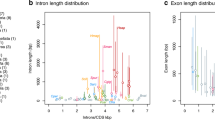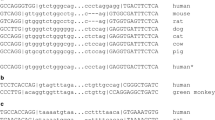Abstract
Exon shuffling has been characterized as one of the major evolutionary forces shaping both the genome and the proteome of eukaryotes. This mechanism was particularly important in the creation of multidomain proteins during animal evolution, bringing a number of functional genetic novelties. Here, genome information from a variety of eukaryotic species was used to address several issues related to the evolutionary history of exon shuffling. By comparing all protein sequences within each species, we were able to characterize exon shuffling signatures throughout metazoans. Intron phase (the position of the intron regarding the codon) and exon symmetry (the pattern of flanking introns for a given exon or block of adjacent exons) were features used to evaluate exon shuffling. We confirmed previous observations that exon shuffling mediated by phase 1 introns (1-1 exon shuffling) is the predominant kind in multicellular animals. Evidence is provided that such pattern was achieved since the early steps of animal evolution, supported by a detectable presence of 1-1 shuffling units in Trichoplax adhaerens and a considerable prevalence of them in Nematostella vectensis. In contrast, Monosiga brevicollis, one of the closest relatives of metazoans, and Arabidopsis thaliana, showed no evidence of 1-1 exon or domain shuffling above what it would be expected by chance. Instead, exon shuffling events are less abundant and predominantly mediated by phase 0 introns (0-0 exon shuffling) in those non-metazoan species. Moreover, an intermediate pattern of 1-1 and 0-0 exon shuffling was observed for the placozoan T. adhaerens, a primitive animal. Finally, characterization of flanking intron phases around domain borders allowed us to identify a common set of symmetric 1-1 domains that have been shuffled throughout the metazoan lineage.





Similar content being viewed by others
References
Altschul SF, Madden TL, Schäffer AA, Zhang J, Zhang Z, Miller W, Lipman DJ (1997) Gapped BLAST and PSI-BLAST: a new generation of protein database search programs. Nucleic Acid Res 25:3389–3402
Aouacheria A, Cluzel C, Lethias C, Gouy M, Garrone R, Exposito JY (2004) Invertebrate data predict an early emergence of vertebrate fibrillar collagen clades and anti-incest model. J Biol Chem 279:47711–47719
Cancherini DV, França GS, de Souza SJ (2010) The role of exon shuffling in shaping protein-protein interaction networks. BMC Genomics 11(Suppl 5):S11
de Souza SJ (2003) The emergence of a synthetic theory of intron evolution. Genetica 118:117–121
de Souza SJ, Long M, Klein JR, Roy S, Lin S, Gilbert W (1998) Toward a resolution of the introns early/late debate: only phase zero introns are correlated with the structure of ancient proteins. Proc Natl Acad Sci USA 95:5094–5099
Dellaporta SL, Xu A, Sagasser S, Moreno MA, Buss L, Schierwater B (2006) Mitochondrial genome of Trichoplax adhaerens supports Placozoa as the basal lower metazoan phylum. Proc Natl Acad Sci USA 103:8751–8756
Eickbush TH (1999) Exon shuffling in retrospect. Science 283:1465–1467
Elrouby N, Bureau TE (2010) Bs1, a new chimeric gene formed by retrotransposon-mediated exon shuffling in maize. Plant Physiol 153:1413–1424
Fedorov A, Suboch G, Bujakov M, Fedorova L (1992) Analysis of nonuniformity in intron phase distribution. Nucleic Acids Res 20:2553–2557
Fedorov A, Cao X, Saxonov S, de Souza SJ, Roy SW, Gilbert W (2001) Intron distribution difference for 276 ancient and 131 modern genes suggests the existence of ancient introns. Proc Natl Acad Sci USA 98:13177–13182
Finn RD, Tate J, Mistry J, Coggill PC, Sammut SJ, Hotz HR, Ceric G, Forslund K, Eddy SR, Sonnhammer EL, Bateman A (2008) The Pfam protein families database. Nucleic Acids Res 36:281–288
Gilbert W (1978) Why genes in pieces? Nature 271:501
Han J, Batey S, Nickson AA, Teichmann SA, Clarke J (2007) The folding and evolution of multidomain proteins. Nat Rev Mol Cell Biol 8:319–330
Hynes RO (2012) The evolution of metazoan extracellular matrix. J Cell Biol 196:671–679
Kaessmann H, Zöllner S, Nekrutenko A, Li WH (2002) Signatures of domain shuffling in the human genome. Genome Res 12:1642–1650
Kawashima T, Kawashima S, Tanaka C, Murai M, Yoneda M, Putnam NH, Rokhsar DS, Kanehisa M, Satoh N, Wada H (2009) Domain shuffling and the evolution of vertebrates. Genome Res 19:1393–1403
King N, Westbrook MJ, Young SL et al (2008) The genome of the choanoflagellate Monosiga brevicollis and the origin of metazoans. Nature 451:783–788
Liu M, Grigoriev A (2004) Protein domains correlate strongly with exons in multiple eukaryote genomes: evidence of exon shuffling? Trends Genet 20:399–403
Liu M, Walch H, Wu S, Grigoriev A (2005) Significant expansion of exon-bordering domains during animal proteome evolution. Nucleic Acids Res 33:95–105
Long M, Langley CH (1993) Natural selection and the origin of jingwei, a chimeric processed functional gene in Drosophila. Science 293:91–95
Long M, Rosenberg C, Gilbert W (1995) Intron phase correlations and the evolution of the intron/exon structure of genes. Proc Natl Acad Sci USA 95:219–223
Long M, de Souza SJ, Rosenberg C, Gilbert W (1996) Exon shuffling and the origin of the mitochondrial targeting function in plant cytochrome c1 precursor. Proc Natl Acad Sci USA 93:7727–7731
Morgante M, Brunner S, Pea G, Fengler K, Zuccolo A, Rafalski A (2005) Gene duplication and exon shuffling by helitron-like transposons generate intraspecies diversity in maize. Nat Genet 37:997–1002
Nguyen HD, Yoshihama M, Kenmochi N (2006) Phase distribution of spliceosomal introns: implications for intron origin. BMC Evol Biol 6:69
Patthy L (1987) Intron-dependent evolution: preferred types of exons and introns. FEBS Lett 214:1–7
Patthy L (1996) Exon shuffling and other ways of module exchange. Matrix Biol 15:301–310
Patthy L (1999) Genome evolution and the evolution of exon suffling- a review. Gene 238:103–114
Patthy L (2003) Modular assembly of genes and the evolution of new functions. Genetica 118:217–231
Putnam NH, Srivastava M, Hellsten U et al (2007) Sea anemone genome reveals ancestral eumetazoan gene repertoire and genomic organization. Science 317:86–94
Qiu W, Schisler N, Stoltzfus A (2004) The evolutionary gain of spliceosomal introns: sequence and phase preferences. Mol Biol Evol 21:1252–1263
Saxonov S, Gilbert W (2003) The universe of exons revisited. Genetica 118:267–278
Smedley D, Haider S, Ballester B, Holland R, London D, Thorisson G, Kasprzyk A (2009) Biomart—biological queries made easy. BMC Genomics 10:22
Srivastava M, Begovic E, Chapman J et al (2008) The Trichoplax adhaerens genome and the nature of placozoans. Nature 454:955–960
Stajich JE, Dietrich FS, Roy SW (2007) Comparative genomic analysis of fungal genomes reveals intron-rich ancestors. Genome Biol 8:R223
Tyler S (2003) Epithelium—the primary building block for metazoan complexity. Integr Comp Biol 43:55–63
Vibranovski MD, Sakabe NJ, de Oliveira RS, de Souza SJ (2005) Signs of ancient and modern exon shuffling are correlated to the distribution of ancient and modern domains along proteins. J Mol Evol 61:341–350
Acknowledgments
Gustavo S. França and Douglas V. Cancherini were supported by FAPESP scholarships.
Author information
Authors and Affiliations
Corresponding author
Electronic supplementary material
Below is the link to the electronic supplementary material.
Rights and permissions
About this article
Cite this article
França, G.S., Cancherini, D.V. & de Souza, S.J. Evolutionary history of exon shuffling. Genetica 140, 249–257 (2012). https://doi.org/10.1007/s10709-012-9676-3
Received:
Accepted:
Published:
Issue Date:
DOI: https://doi.org/10.1007/s10709-012-9676-3




